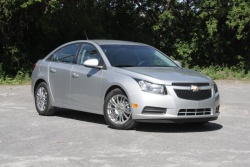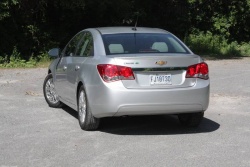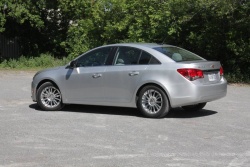 2011 Chevrolet Cruze Eco. Click image to enlarge |
|
Related links
Manufacturer’s web site |
Review and photos by Chris Chase
Photo Gallery:
2011 Chevrolet Cruze
Hybrids are good at saving fuel, but they cost thousands more than comparable gasoline-powered cars, and it can take years of driving to make back that difference in purchase price. There are a number of gas-only cars on the market now, however, that approach hybrid efficiency at a more palatable price.
Chevrolet is the latest vehicle to venture into the fuel-saving fray with its gas-only miser Cruze Eco model. The Cruze is Chevy’s mainstream compact sedan, playing in the same sandbox as notables like the Honda Civic and Hyundai Elantra, two cars I single out for reasons that will be explained shortly.
To all appearances, this car is as much a mainstreamer as any Cruze trim, save for unique wheels (if you have an eye for such things), a lower front bumper and different grille (more on that shortly) and subtle badging.
  2011 Chevrolet Cruze Eco. Click image to enlarge |
The lower front bumper valance is part of a suite of design elements – most of which are invisible to the casual observer – that also includes extra underbody panels, rear spoiler, lowered suspension and shutters behind the lower front grille that all work together to improve the Cruze’s aerodynamics. Mechanically, the Eco gets longer transmission gearing (which is to say, the engine turns at a lower rpm at a given road speed than a non-Eco Cruze), plus low rolling-resistance tires mounted on lightweight 17-inch alloy wheels.
At 1,365 kg (3,009 lbs), the Eco is also about 100 kg (220 lbs) lighter than the comparable LT Turbo model. That’s the result of changes to the car’s body, the lighter wheels (each one is 2.4 kg lighter apiece than the 16-inchers on the LT Turbo) and the omission of a spare tire (which is replaced by a pump and a can of tire sealant). Even with those measures in place, the Cruze is still heavier than stickshift versions of the Civic EX and Elantra, respectively.
Those thrift-minded changes are matched exclusively with the 1.4-litre turbocharged four-cylinder that is positioned as the premium choice, next to the Cruze’s base 1.8-litre engine. Power numbers are 138 horsepower and 148 lb.-ft. of torque for my tester’s turbo mill, where the 1.8-litre’s ratings are 136 hp/123 lb.-ft. A six-speed manual is standard in the Eco (in fact, the Eco is the only Cruze that pairs the turbo engine with a stickshift), and the same six-speed automatic offered elsewhere in the Cruze line-up is optional.
Taken all together, the aero add-ons and mechanical changes help drop the Cruze’s fuel consumption ratings to 7.2/4.6 L/100 km (city/highway) with the manual transmission, and 7.8/5.1 with the automatic. For comparison, the 1.8-litre Cruze LS is rated at 8.5/5.5 with the stickshift, while the LT Turbo model and its standard-kit auto-box is pegged at 9.2/5.6 L/100 km. Notable competitors in the economy wars are the 2012 Honda Civic, rated at 7.2/5.0 L/100 km with an automatic transmission, and the 2011 Hyundai Elantra, which does even better, at 6.9/4.9 with the automatic.











